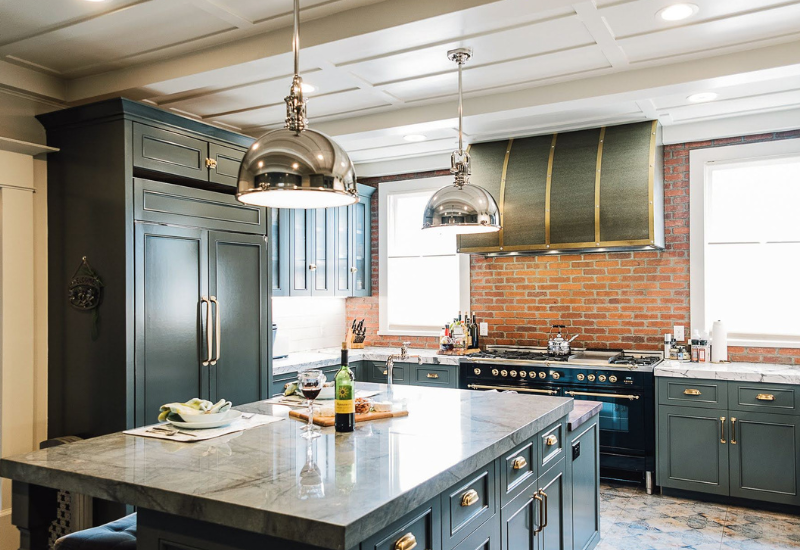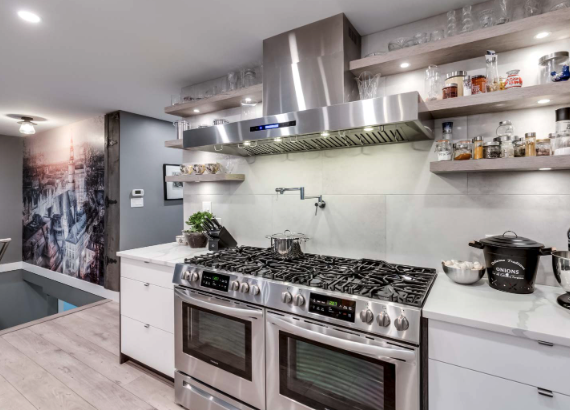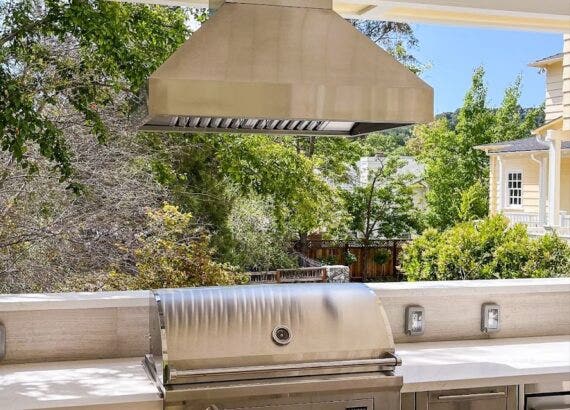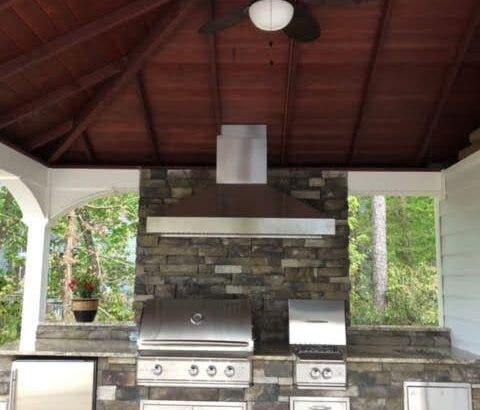How to Choose a Range Hood – Range Hood Buyer’s Guide 2024

When you’re in the market for a range hood, you may find yourself swamped with an array of options, from size and style to features and functionality. Fear not! This buyer’s guide will walk you through the essentials to help you pick the perfect hood for your kitchen. With various types available, each offering distinct benefits and drawbacks, it’s crucial to consider aspects like your kitchen size, cooking style, and design preferences.
Key Takeaways
- Consider your kitchen size and type of cooking to find the right size and power.
- Decide between ducted and ductless models based on your kitchen’s ventilation needs.
- Keep energy efficiency and maintenance in mind, and choose a design that complements your kitchen aesthetic.
Table of Contents
Different Kinds of Range Hoods
The type you need is mainly dictated by where you are planning on placing your range or cooktop.
Wall Mounted
Wall mounted hoods are placed above the stove on the wall, offering a stylish centerpiece for your kitchen. They effectively eliminate smoke and odors. These hoods can be both functional and eye-catching.
Under Cabinet
Under cabinet ones are positioned below the cabinets, providing a great enhancement to your kitchen. They are a fantastic choice if you have limited space and seek an unobtrusive ventilation solution as well.
Island Mounted
These are mounted in kitchens over a stove placed in an island situation. Suspended from the ceiling, island mounted range hoods can be both fashionable and practical additions to your kitchen.
Range Hood Inserts
Range hood inserts are designed for an install into a custom built hood. Inserts are the guts of the hood that make your custom design come to life. Installed inside a custom hood or cabinet, they offer the essential ventilation without the visible exterior of a conventional range hood. They maintain the aesthetic of your custom kitchen design.
Size Considerations
When selecting a range hood, it is important to choose one that is properly sized for your grill or cooktop. The general recommendation is to pick one that is at least as wide as the cooking surface and ideally 6 inches wider.
Having a hood that extends 6 inches beyond the edges of your range allows for maximum ventilation coverage to capture smoke and vapors.
The extra coverage on the sides is key because smoke and steam have a tendency to escape to the sides as they rise. An undersized range hood may fall short of covering the entire cooking surface area, leaving the edges exposed and allowing contaminants into the outdoor area.
Grill masters will benefit from that extra hood width in terms of keeping their cooking space clear and avoiding unwanted smoke blowing more easily out of the effective capture space of the hood.
For Spacious Kitchens
For those with larger kitchens, it’s essential to choose one that is proportional to your space. A bigger kitchen requires a more substantial hood to effectively eliminate cooking smells and smoke. If your kitchen has a large island range, a larger hood, such as the PLFI 750.60, might be the ideal choice.
For Compact Spaces
If you have limited space under your cabinets, a low-profile hood like the PLJW 185.30 could be a better option. Smaller kitchens can benefit from a hood that is both functional and visually unobtrusive. By selecting the right size for your space, you’ll ensure efficient smoke and odor removal without compromising your kitchen’s design.
Cooking Styles and Ventilation Requirements
High-Temperature Cooking
If you frequently engage in high heat cooking or frying, it’s essential to have a hood with a high CFM (cubic feet per minute) rating. This will effectively remove smoke and grease from your kitchen.
Powerful Airflow Rating (CFM)
The power of a range hood is determined by the blower capacity, which relates to how well it can eliminate smoke, steam, and cooking odors. As an avid cook, opt for one with robust blower capacity, like a model that produces 2,000 CFM (e.g., PLFW 832.60 with Dual blower).
Efficient Exhaust System
Choosing between a ducted and ductless range hood is another key factor. Ducted hoods vent smoke and odors outside through ducts, while ductless hoods filter air and recirculate it back into the kitchen. If venting outside isn’t an option, consider a model easily convertible to a ductless system, like the PLJW 12036 with a recirculating kit.
A range hood’s design, energy efficiency, and maintenance ease should also be taken into account when making a decision. With the right hood, your kitchen will be a cleaner, healthier, and more enjoyable space for cooking and entertaining.
Ducted vs. Ductless
Ducted Hoods
Ducted range hoods vent smoke and odors to the outside through a duct, providing a highly effective way of removing cooking fumes from your kitchen. If you do a lot of high heat cooking or frying, a ducted hood with a high CFM (cubic feet per minute) rating like the PLFW 83260 with a dual blower that produces 2,000 CFM would be an excellent choice.
Ductless Hoods
Ductless hoods filter the air and recirculate it back into the kitchen. If you’re unable to vent to the outside using a duct pipe, a ductless one can still help improve the air quality in your kitchen. Some features to look for include:
- Energy-efficient LED lights
- Multiple speed settings
- Easy-to-clean filters
Conversion to Ductless
Some hoods can be easily converted into ductless if needed. For example, the PLJW 12036 can be converted into a ductless hood by placing a recirculating kit on top of the hood. This flexibility allows you to choose a hood that best suits your kitchen layout and ventilation needs.
Keep in mind your kitchen size, the type of cooking you do, and the design when choosing between ducted and ductless. Both types can improve the value and function of your kitchen.
Design and Aesthetics
Complementing Your Kitchen Theme
One important aspect to consider is how well it complements your kitchen’s existing decor. Your range hood can act as a statement piece that highlights your kitchen’s style and sense of design.
Modern Touch
If you’re seeking a modern, sleek appearance for your kitchen, a hood like the PLFW Vector 36, complete with a brushed stainless steel finish and a unique curved front, could be the perfect addition. This particular style will help to achieve a fresh and contemporary atmosphere within your space.
Present-Day Elegance
For those who prefer an up-to-the-minute appearance combined with clean lines and minimalism, the PLFI 54430 may be the ideal choice. This hood features a curved glass surface alongside hand-polished stainless steel, resulting in a harmonious blend of contemporary sophistication.
As you explore the different hood styles and designs, be sure to select the one that best complements your kitchen’s overall aesthetic and meets your functional requirements. That way, your kitchen will become not only a cleaner and healthier environment for cooking but also a more enjoyable space for entertaining guests.
Energy Efficiency
LED Lighting
LED lights are an energy-efficient option for your range hood. These lights provide optimal illumination for cooking while consuming less energy compared to traditional incandescent bulbs. It’s important to select a range hood with LED lighting to ensure reduced energy consumption and improved visibility while cooking.
Speed Settings
Multiple speed settings allow you to adjust the fan speed according to your specific cooking needs. High-speed settings are essential for intense cooking sessions that produce considerable smoke and grease, while lower-speed settings can be used during less demanding cooking activities. Choosing one with various speed settings helps to optimize energy efficiency by allowing you to select the appropriate airflow without unnecessarily wasting energy.
Maintenance
It’s crucial to think about the ease of cleaning and maintaining your chosen hood. A well-maintained hood offers not only a cleaner and healthier kitchen atmosphere but also a pleasant cooking and dining experience.
Keeping your hood clean helps to ensure its efficiency in removing smoke, steam, and odors from your kitchen. During your search, pay attention to the ease of disassembly and the accessibility of filters. Many models have removable and dishwasher-safe filters, which simplify the cleaning process.
Moreover, seek for energy-efficient features, such as LED lights and multiple speed settings, that will conserve electricity while providing optimal extraction power. Remember that a durable, well-maintained range hood will continue to contribute to the aesthetics and functionality of your kitchen for years to come.
What types of range hoods are available?
- Wall-mounted range hoods
- Under-cabinet range hoods
- Island-mounted range hoods
- Range hood inserts
What factors should I consider based on my cooking habits?
The way you use your kitchen and cooking space should significantly influence the type of range hood you choose. If you mainly cook quick, simple meals or reheat leftovers, you can likely get by with a basic hood with a 600-900 CFM blower.
However, if you frequently cook elaborate multi-course meals or cook with lots of oil and spices, you’ll need a more powerful 1000+ CFM commercial-grade hood. The higher airflow ratings are better equipped to handle greater smoke and aroma output from extensive cooking sessions.
You should also think about what and how often you cook – if you use your stovetop or oven multiple times a week for full meals, opt for a durable stainless steel hood rather than a cheaper aluminum model. And if your cooking goes hand-in-hand with entertaining, select a hood with a low noise level so as not to disrupt conversations.
Those who cook a variety of cuisines may want a hood with lighting to illuminate the cooking surface. No matter your habits, choosing the right strength, material, and features based on your specific needs will ensure your hood performs optimally for your lifestyle.
Considering how you cook before making a purchase will help narrow down the options to the best model.
Should I choose a ducted or ductless range hood?
Ducted range hoods are connected to the outside via ventilation ductwork, which allows grease, odors, and contaminants to be completely expelled from the kitchen. This gives you the best air purification, but properly installing the ductwork is an important investment to ensure optimal ventilation.
Ductless (recirculating) hoods filter out many contaminants and then recirculate the air back into the kitchen – no ducting required.
However, this means odors and grease particles can gradually build back up over time. Ductless hoods are typically less expensive and easier to install. In general, ducted hoods are ideal if you do a lot of frying or grilling and want maximum purification.
Ductless models may suit those with milder cooking demands or who want a simpler installation.
You’ll have to weigh the pros and cons of ducting requirements, purification effectiveness, and installation costs for your needs. Consulting with kitchen designers can help make the right choice between ducted and ductless range hoods.
What energy-efficient features should I keep in mind?
Look for range hoods that have LED lights and multiple speed settings.
How can I ensure easy maintenance of my hood?
As with anything regular maintenance helps keep your hood working efficiently and looking its best.
The easiest way to maintain a range hood is by frequently cleaning the metal grease filters. Most manufacturers recommend soaking and washing grease filters in hot soapy water or the dishwasher monthly.
Additionally, it’s a good idea to occasionally wash the hood canopy using a degreasing cleanser and soft cloth.
For optimal performance, replace the charcoal filter on ductless range hoods every 6-12 months, depending on usage.
Some other simple tips are keeping fan blades dust-free and making sure all lighting is functioning.
Following the manufacturer’s suggested maintenance guidelines will extend the life of your hood. And it will stay in great shape.
Wrapping Things Up
Choosing the perfect range hood for your kitchen can be a breeze with the right information. Keep in mind the size of your kitchen and opt for a correctly sized hood that effectively eliminates smoke and odors. Don’t forget to take into account the type of cooking you usually do and select a range hood with the appropriate CFM rating.
Deciding between ducted or ductless depends on your ability to vent to the outside and factor in the design that reflects the style of your kitchen. For a sleek and modern look, explore options like the brushed stainless steel finish, while for a more contemporary vibe, go for curved glass and hand-polished stainless steel finish.
Remember to prioritize energy efficiency with features such as LED lights and multiple speed settings. Maintenance is essential, too, so make sure you think about the ease of cleaning and maintaining your chosen hood.
With these tips in mind, your quest for an ideal range hood should be smooth and successful, creating a cleaner, healthier, and more enjoyable environment for you to cook and entertain in your kitchen.







Comments are closed.